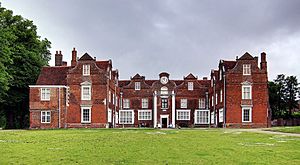Samuel Mayart facts for kids
Sir Samuel Mayart (born in 1587, died around 1646) was an important judge in Ireland during the 1600s. He was born in England but spent most of his career in Ireland. He was also known for his ideas about how governments should work.
Contents
Becoming a Lawyer
Samuel Mayart was born in Ipswich, Suffolk, England, in 1587. His father, Gilbert Mayart, came from Flanders (which is now part of Belgium). Samuel went to Merton College, Oxford, a famous university, in 1604.
He then studied law at the Middle Temple in London starting in 1607. By 1614, he was "called to the Bar." This meant he had finished his training and could now work as a lawyer.
Soon after, he decided to move to Ireland to practice law. He became a lawyer in Ireland in 1616 and joined the King's Inns, a special place for lawyers, in the same year. He later became the Treasurer of the King's Inns in 1633. Samuel Mayart lived near Dublin, in an area called Oxmantown. He was a strong Protestant and followed a strict religious group called the Puritans. He was also connected to James Ussher, who was the Archbishop of Armagh, through his second wife.
Working as a Judge
In 1624, a position for a judge opened up in the Court of Common Pleas (Ireland). Samuel Mayart really wanted this job. He even offered the English Crown (the King's government) £300 for it, which was a lot of money at the time!
Some people wondered if he was good enough to be a judge. But two important lawyers, Sir Richard Bolton and his son Edward, said he was honest and skilled in law. After some waiting, he was appointed as a judge in 1626.
He was made a knight in 1631, so he became "Sir Samuel Mayart." When the Irish Parliament met, he often attended the Irish House of Lords to give legal advice to the noblemen. He also worked as a master in the Court of Chancery (Ireland) and traveled around the country as a judge.
The Case of Land Ownership (1637)
In 1637, all the top judges in Ireland were asked for their opinion on a very important case. It was called the Case of Tenures upon the Commission of Defective Titles. This case was set up by the English government to find a legal reason to take land from Catholic landowners in Ireland. They especially wanted to clear the way for a big plan called the Plantation of Connacht. This plan involved moving English and Scottish settlers onto Irish land.
Most of the judges (five out of seven) agreed with the government. They said that if land was not passed down through families in a certain way, then the ownership was not valid. This gave the King a legal reason to take the land.
However, Samuel Mayart was one of two judges who disagreed with this decision. The other judge was Hugh de Cressy. Mayart disagreed for technical reasons related to the law.
His decision to disagree showed he was a man of integrity and courage. The Plantation of Connacht was a very important project for Thomas Wentworth, 1st Earl of Strafford. He was the powerful Lord Lieutenant of Ireland, who was like the King's main representative. Strafford did not like it when people questioned his plans. He believed judges should always rule in favor of the King. Mayart's decision to go against Strafford's wishes was a brave one.
After 1637, we don't know much about Mayart's career for a few years. In 1641, the Irish Parliament voted to give him money because his salary had been reduced earlier.
Ideas About Government
In 1644, Samuel Mayart became involved in a big political argument. An anonymous book called A Declaration setting forth how and by what means the laws and statutes of England came to be of force in Ireland was published. This book argued that Ireland had always had its own independent Parliament. It said that English laws could only apply in Ireland if the Irish Parliament agreed to them.
Many people thought that Mayart's friend, Sir Richard Bolton, who was then the Lord Chancellor of Ireland, had written the book. Because this was a sensitive topic, the Irish House of Lords asked the judges for their advice.
Mayart decided to write his own "Answer" to the book. His answer was well-received. He argued strongly that the Parliament of Ireland had always been under the authority of the English Parliament. He also helped both parts of the Irish Parliament communicate about the issue.
Later Life and Family
The last time Samuel Mayart was mentioned was in February 1646, when he was attending the House of Lords. It is believed he died soon after that.
He was married three times but did not have any children. We don't know much about his first wife. His second wife was Mary Smith. She had been married before to Henry Ussher, who was also an Archbishop of Armagh, and to William FitzWilliam. His third wife was Dorcas Newcomen. She had also been married before to Francis White and George Richards.


